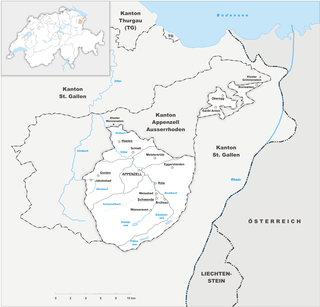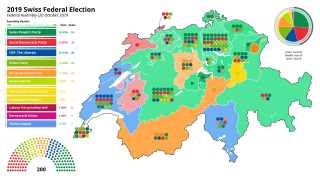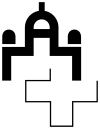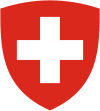
The 26 cantons of Switzerland are the member states of the Swiss Confederation. The nucleus of the Swiss Confederacy in the form of the first three confederate allies used to be referred to as the Waldstätte. Two important periods in the development of the Old Swiss Confederacy are summarized by the terms Acht Orte and Dreizehn Orte.

Appenzell Innerrhoden, in English sometimes Appenzell Inner-Rhodes, is one of the 26 cantons forming the Swiss Confederation. It is composed of six districts. The seat of the government and parliament is Appenzell. It is traditionally considered a "half-canton", the other half being Appenzell Ausserrhoden.

Appenzell Ausserrhoden, in English sometimes Appenzell Outer Rhodes, is one of the 26 cantons forming the Swiss Confederation. It is composed of twenty municipalities. The seat of the government and parliament is Herisau, and the seat of judicial authorities are in Trogen. It is traditionally considered a "half-canton", the other half being Appenzell Innerrhoden.
Landammann, is the German title used by the chief magistrate in certain Cantons of Switzerland and at times featured in the Head of state's style at the confederal level.
The Swiss Confederation comprises the 26 cantons of Switzerland.
This local electoral calendar for the year 2010 lists the subnational elections held in 2010 in the de jure and de facto sovereign states. By-elections and sub-national referendums are also included.

The German-speaking part of Switzerland comprises about 65 percent of Switzerland.

Federal elections were held in Switzerland between 1 and 27 October 1848. The Radical Left emerged as the largest group, winning 79 of the 111 seats in the National Council.

Federal elections were held in Switzerland on 26 October 1851. The Radical Left remained the largest group in the National Council, winning 78 of the 120 seats.

Federal elections were held in Switzerland on 29 October 1854. The Radical Left remained the largest group in the National Council, winning 80 of the 120 seats.

Federal elections were held in Switzerland on 28 October 1857. The Radical Left remained the largest group in the National Council, winning 80 of the 120 seats.

Federal elections were held in Switzerland on 28 October 1860. Despite large losses, the Radical Left remained the largest group in the National Council, winning 64 of the 120 seats.

Federal elections were held in Switzerland on 25 October 1863. The Radical Left remained the largest group in the National Council, but lost its majority for the first time since 1848.

Federal elections were held in Switzerland on 28 October 1866. The Radical Left remained the largest group in the National Council.

Federal elections were held in Switzerland on 31 October 1869. The Radical Left remained the largest group in the National Council.

Federal elections were held in Switzerland on 27 October 1872. The Radical Left remained the largest group in the National Council.

Federal elections were held in Switzerland on 20 October 2019 to elect all members of both houses of the Federal Assembly. This was followed by the 2019 election to the Swiss Federal Council, the federal executive, by the United Federal Assembly.
There are 26 constituencies in Switzerland – one for each of the 26 cantons of Switzerland – for the election of the National Council and the Council of States.













